Laws Of Motion MCQs
NEET Physics For Laws of Motion Multiple Choice Questions
Question 1. Physical independence of force is a consequence of:
- third law of motion
- second law of motion
- first law of motion
- all of these laws
Answer: 3. first law of motion
Newton’s first law of motion is related to the physical independence of force.
Question 2. A ball of mass 0.15 kg is dropped from a height of 10 m, strikes the ground, and rebounds to the same height. The magnitude of impulse imparted to the ball is (g = 10 m/s²) nearly:
- 0 kg m/s
- 4.2 kg m/s
- 2.1 kg m/s
- 1.4 kg m/s
Answer: 2. 4.2 kg m/s
Given,
A ball of mass 0.15 kg is dropped from a height of 10 m, strikes the ground, and rebounds to the same height.
height (h) = 10m
mass (m) = 0.15 kg
⇒ Velocity at ground, v =\(\sqrt{2 g h}\)
v=\(\sqrt{2 \times 10 \times 10}\)
=\(10 \sqrt{2} \mathrm{~m} / \mathrm{s}\)
⇒ \(\Delta \mathrm{P}=\mathrm{P}_f-\mathrm{P}_i\)
⇒ Since rebound takes place for the ball to reach the same height, hence, Pf =-Pi
=\((0.15 \times 10 \sqrt{2})\)
⇒ \(\Delta \mathrm{P} =3 \sqrt{2}\)
=4.2 kg m/s
Laws Of Motion MCQs
Question 3. The moment of the force F =\(4 \hat{i}+5 \hat{j}-6 \hat{k}\) at (2, 0 – 3)m about the point (2,-2,-2), is given by:
- \(-7 \hat{i}+8 \hat{j}-4 \hat{k}\)
- \(4 \hat{i}+\hat{j}-8 \hat{k}\)
- \(-8 \hat{i}-4 \hat{j}-7 \hat{k}\)
- \(-7 \hat{i}-4 \hat{j}-8 \hat{k}\)
Answer: 4. \(-7 \hat{i}-4 \hat{j}-8 \hat{k}\)
Read and Learn More NEET Physics MCQs
Moment of force = Torque
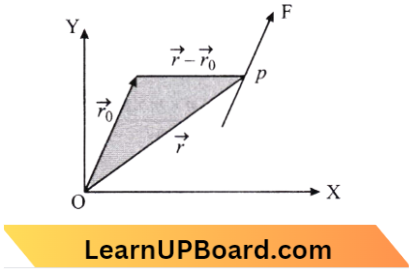
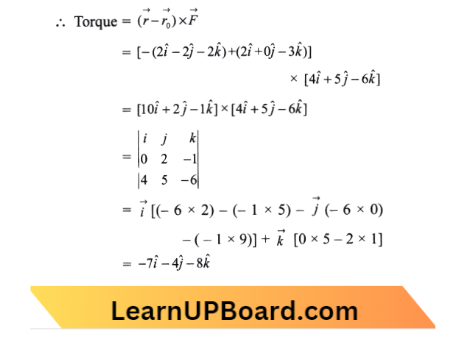
⇒ \(\mathrm{F}=4 \hat{i}+5 \hat{j}-6 \hat{k}\)
⇒ \(r_0=2 \hat{i}+0 \hat{j}-3 \hat{k}\)
∴ \(\mathrm{r} =2 \hat{i}+2 \hat{j}-2 \hat{k}\)
Question 4. The force F acting on a particle of mass m is indicated by the force-time graph shown below. The change in momentum of the particle over the time interval from 0 s to 8 s is:
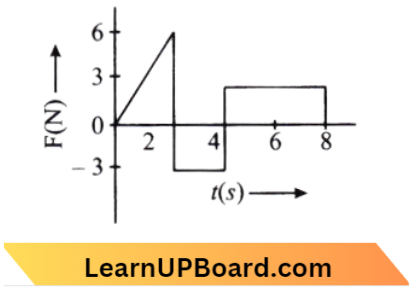
- 14 Ns
- 20 Ns
- 12 Ns
- 6 Ns
Answer: 3. 12 Ns
The f-t graph is
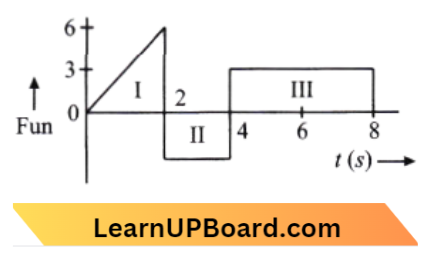
⇒ Now, Change of momentum,For 1st → ΔP1 = \(\frac{1}{2}\) x 2 x 6 = 6 kg-m/s
⇒ For 2nd– ΔP2 = 2 (- 3) = – 6 kg-m/s ⇒ For 3rd ΔP3 = 4X3 = 12 kg-m/s
∴ Total change in momentum,ΔP = ΔP1 + ΔP2 + ΔP3 = 6-6+12 = 12N-s.
Laws Of Motion Questions For NEET
Question 5. Three blocks with masses m, 2m, and 3m are connected by strings, as shown in the figure. After an upward force F is applied on block m, the masses move upward at constant speed v. What is the net force on the block of mass 2m? (g is the acceleration due to gravity)
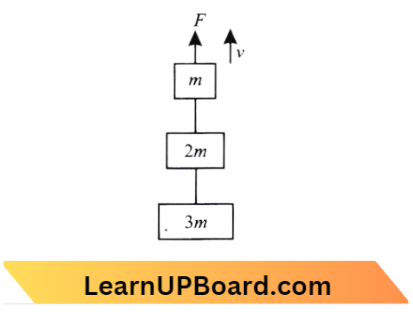
- Zero
- 2 mg
- 3 mg
- 6 mg
Answer: 1. Zero
As a block of mass 2 m moves with constant velocity the net force is 2 cm [Since, Velocity = constant
⇒ acceleration = 0
∴ F = m x a = m x 0 = 0
Question 6. A person holding a rifle (mass of person and rifle together is 100 kg) stands on a smooth surface and fires 10 shots horizontally, in 5 s. Each bullet has a mass of 10 g with a muzzle velocity of 800 ms-1. The final velocity acquired by the person and the average force exerted on the person are:
- – 0.08 ms-4, 16 N
- – 0.8 ms-4,16 N
- – 0.08 ms-4, 16 N
- – 0.08 ms-4, 16 N
Answer: 2. – 0.8 ms-4,16 N
Given
A person holding a rifle (mass of person and rifle together is 100 kg) stands on a smooth surface and fires 10 shots horizontally, in 5 s. Each bullet has a mass of 10 g with a muzzle velocity of 800 ms-1.
Using the law of conservation of moments, Initial momentum = mu1 + mu2
⇒ final momentum = nmv1+ (M- nm)v2 mu1 + mu2 = nmv1 + (M- nm)v2
⇒ 0=\(\frac{10 \times 10}{1000} \times 800+\left(100-\frac{10 \times 10}{1000}\right) v_2\)
⇒ -80=\(\frac{999}{10} v_2\)
∴ v2 = -0.8ms-1
⇒ And average force exerted on the person\(\frac{n \times m \times u}{\Delta t}\)
=\(\frac{10 \times \frac{10}{1000} \times 800}{5}\)
=\(\frac{80}{5}=16 \mathrm{~N}\)
Laws Of Motion Questions For NEET
Question 7. A boy standing at the top of a tower of 20 m height drops a stone. Assuming g = 10 ms-2, the velocity with which it hits the ground is:
- 20 m/s
- 40 m/s
- 5 m/s
- 10 m/s
Answer: 1. 20 m/s
∴ Since, \(v=\sqrt{2 g h}=\sqrt{2 \times 10 \times 20}=20 \mathrm{~m} / \mathrm{sec}\)
Question 8. A body, under the action of a force\(\overrightarrow{\mathrm{F}}=6 \hat{i}-8 \hat{j}+10 \hat{k}\), acquires an acceleration of 1 ms-2. The mass of this body must be:
- \(2 \sqrt{10} \mathrm{~kg}\)
- 10
- 20
- \(10 \sqrt{2} \mathrm{~kg}\)
Answer: 4. \(10 \sqrt{2} \mathrm{~kg}\)
We know that, force = mass x acceleration
⇒ \(\vec{F} =6 \hat{i}-8 \hat{j}+10 \hat{k}\)
⇒ |F| =\(\sqrt{6^2+(8)^2+10^2}\)
=\(\sqrt{36+64+100}\)
=\(10 \sqrt{2} \mathrm{~N}\)
⇒ a =\(1 \mathrm{~ms}^{-2}\)
∴ m =\(\frac{10 \sqrt{2}}{1}=10 \sqrt{2} \mathrm{~kg}\)
Question 9. An object of mass 3 kg is at rest. Now a force of \(\vec{F}=6 t^2 \hat{i}+4 \hat{j}\) is applied on the object then velocity of object at t = 3 s is:
- \(18 \hat{i}+3 \hat{j}\)
- \(18 \hat{i}+6 \hat{j}\)
- \(3 \hat{i}+18 \hat{j}\)
- \(18 \hat{i}+4 \hat{j}\)
Answer: 1. \(18 \hat{i}+3 \hat{j}\)
⇒ Mass, m = 3 kg, force, F =\(\mathrm{F}=6 \mathrm{t} \hat{i}+4 t \hat{j}\)
⇒ Acceleration a =\(\frac{F}{m}=\frac{6 t^2 \hat{i}+4 t \hat{j}}{3}\)
=\(2 t^2 \hat{i}+\frac{4}{3} t \hat{j}\)
⇒ \(\mathrm{a} =\frac{d v}{d t}=2 t^2 \hat{i}+\frac{4}{3} t \hat{j}\)
⇒ DV =\(\left(2 t^2 \hat{i}+\frac{4}{3} t \hat{j}\right) d t\)
⇒ v =\(\int_0^3\left(2 t^2 \hat{i}+\frac{4}{3} t \hat{j}\right) d t\)
=\(\frac{2}{3} t^3 \hat{i}+\left.\frac{4}{6} t^2 \hat{j}\right|_0 ^3=18 \hat{i}+6 \hat{j}\)
NEET Physics MCQs
Question 10. A cricketer catches a ball of mass 150 gm in 0.1 sec moving with a speed of 20 m/s, then he experiences a force of
- 300 N
- 30 N
- 3 N
- 0.3 N
Answer: 2. 30 N
Impulse = Change in momentum \(\mathrm{F} \cdot \Delta \mathrm{t} =\mathrm{m} \mathrm{v}\)
⇒ \(\mathrm{F}=\frac{m \cdot v}{\Delta t}\)
=\(\frac{150 \times 10^{-3} \times 20}{0.1}=30 \mathrm{~N}\)
Question 11. If the force on a rocket, moving with a velocity of 300 m/s is 210 N, then the rate of combustion of the fuel is:
- 0.07 kg/s
- 1.4 kg/s
- 0.7 kg/s
- 10.7 kg/s
Answer: 2. 1.4 kg/s
⇒ \(\text { Force }=\frac{d}{d t}(\text { momentum })\)
=\(\frac{d}{d t}(m v)=v\left(\frac{d m}{d t}\right)\)
⇒ \(210=300\left(\frac{d m}{d t}\right)\)
⇒ \(\frac{d m}{d t}\)= rate of combustion
=\(\frac{210}{300}=0.7 \mathrm{~kg} / \mathrm{s}\)
NEET Physics MCQs
Question 12. A bullet is fired from a gun. The force on the bullet is given by F = 600 – 2 x 105 t. Where F is in Newton and t in seconds. The force on the bullet becomes zero as soon as it leaves the barrel. What is the average impulse imparted to the bullet?
- 9 Ns
- zero
- 1.8 Ns
- 0.9 Ns
Answer: 4. 0.9 Ns
Given
A bullet is fired from a gun. The force on the bullet is given by F = 600 – 2 x 105 t. Where F is in Newton and t in seconds. The force on the bullet becomes zero as soon as it leaves the barrel.
F =0,600-2 x times 105 t=0
t =\(\frac{600}{2 \times 10^5}=3 \times 10^{-3} \mathrm{~s}\)
⇒ Now, Impulse I =\(\int_0^t F d t=\int_0^t\left(600-2 \times 10^5 t\right) d t\)
=\(600 t-2 \times 10^5 \frac{t^2}{2}\)
Question 13. A 5000 kg rocket is set for vertical firing. The exhaust speed is 800 m s-1. To give an initial upward acceleration of 20 m s-1. the amount of gas ejected per second to supply the needed thrust will be (g = 10 m s-2):
- 185. kgs-1
- 187.5 kgs-1
- 127.5 kg s-1
- 137.5 kg s-1
Answer: 2. 187.5 kgs-1
\(\text { Thrust }=\mathrm{M}(g+a)=u \frac{d m}{d t}\) \(\frac{d m}{d t} =\frac{M(g+a)}{u}=\frac{5000(10+20)}{800}\)=\(187.5 \mathrm{~kg} / \mathrm{s}\)
Class 11 Laws Of Motion MCQs
Question 14. A force of 6 N acts on a body at rest and of mass 1 kg. During this time, the body attains a velocity of 30 m/s. The time for which the force acts on the body is:
- 7 seconds
- 5 seconds
- 10 seconds
- 8 seconds
Answer: 2. 5 seconds
Force (F) = 6 N;
Initial velocity (u) = 0;
Mass (m) = 1 kg and final velocity (v) = 30 m/s.
Acceleration \((a)=\frac{F}{m}=\frac{6}{1}=6 \mathrm{~m} / \mathrm{s}^2\)
velocity, (v) = 30 = u + at = 0 + 6 x t
Question 15. A 10 N force is applied to a body to produce an acceleration of 1 m/s². The mass of the body is:
- 15 kg
- 20 kg
- 10 kg
- 5 kg
Answer: 3. 10 kg
Force (F) = 10 N and acceleration (a) = 1 m/s².
⇒ Mass(m)=\(\frac{F}{a}=\frac{10}{1}\) = 10kg
Class 11 Laws Of Motion MCQs
Question 16. In a rocket, fuel bums at the rate of 1 kg/s. This fuel is ejected from the rocket with a velocity of 60 km/s. This exerts a force on the rocket equal to:
- 6000 N
- 60000
- 60 N
- 600 N
Answer: 2. 60000
Rate Of Burning Of Fuel\(\left(\frac{d m}{d t}\right)\)=1kg/s-1
and velocity of ejected fuel, (v) = 60 km/s = 60 x 103 m/s
⇒Force = Rate of change of momentum\(\frac{d p}{d t}=\frac{d(m v)}{d t}=v \frac{d m}{d t}\)
∴ (60 x 103)x 1 =60000N
Question 17. A satellite in force-free space sweeps stationary interplanetary dust at a rate of \(\frac{d M}{d t}=\alpha v\), where M is mass and v is the speed of the satellite and a is a constant. The acceleration of the satellite is:
- \(\frac{-\alpha v^2}{2 M}\)
- \(-\alpha v\)
- \(\frac{-2 \alpha v^2}{M}\)
- \(\frac{-\alpha v^2}{M}\)
Answer: 4. \(\frac{-\alpha v^2}{M}\)
Given
A satellite in force-free space sweeps stationary interplanetary dust at a rate of \(\frac{d M}{d t}=\alpha v\), where M is mass and v is the speed of the satellite and a is a constant.
⇒ Rate of change of mass \(\frac{d M}{d t} \alpha \mathrm{v}\)
⇒ Retarding force = Rate of change of momentum
= Velocity x Rate of change in mass
⇒ \(-v \times \frac{d M}{d t}= -v \times \alpha v=\alpha v^2\)
∴ Therefore, acceleration=\(-\frac{\alpha v^2}{M}\)
Important MCQs On Laws Of Motion For NEET
Question 18. A particle of mass m is moving with a uniform velocity V1. It is given an impulse such that its velocity becomes V2– The impulse is equal to:
- \(m\left[\left|\mathbf{v}_2\right| \times\left|\mathbf{v}_1\right|\right]\)
- \(\frac{1}{2} m\left[v_2^2-v_1^2\right]\)
- \(m\left[\mathrm{v}_1+\mathrm{v}_2\right]\)
- \(m\left(\mathrm{v}_2-\mathrm{v}_1\right)\)
Answer: 4. \(m\left(\mathrm{v}_2-\mathrm{v}_1\right)\)
Impulse is a vector quantity and is equal to the change in momentum of the body thus,(same as F x / where t is short)
∴ Impulse = mv2 – mv1 = m(v2 – v1)
Question 19. A 600 kg rocket is set for a vertical firing. If the exhaust speed is 1000 m s-1, the mass of the gas ejected per second to supply the thrust needed to overcome the weight of the rocket is:
- 117.6kgs-1
- 58.6kgs-1
- 6 kg s-1
- 76.4 kg s-1
Answer: 3. 6 kg s-1
⇒ Thrust is the force with which the rocket moves upward given by \(\mathrm{F}=\mathrm{u} \frac{d m}{d t}\)
⇒ Thus the mass of the gas ejected per second to supply the thrust needed to overcome the weight of the rocket is \(\frac{d m}{d t}=\frac{F}{u}=\frac{m \times a}{u}\)
∴ or \(\frac{d m}{d t}=\frac{600 \times 10}{1000}=6 \mathrm{~kg} \mathrm{~s}^{-1}\)
Important MCQs On Laws Of Motion For NEET
Question 20. A rigid ball of mass m strikes a rigid wall at 60° and gets reflected without loss of speed as shown in the figure. The value of impulse imparted by the wall on the ball will be:
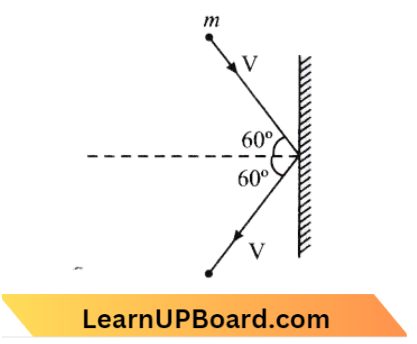
- mv
- 2mv
- mv/2
- mv/3
Answer: 1. mv
∴ Impulse,\(|\overrightarrow{\Delta P}|=m|\overrightarrow{\Delta V}|\)= m (2 x cos 60°) = mv
Question 21. A body of mass M hits normally a rigid wall with velocity v and bounces back with the same velocity. The impulse experiment by the body is:
- 2 Mv
- 1.5 Mv
- zero
- Mv
Answer: 1. 2 Mv
Impulse = Change in linear momentum = MV – (-MV) = 2 MV
Question 22. A man of 50 kg mass is standing in a gravity-free space at a height of 10 m above the floor. He throws a stone of 0.5 kg mass downwards with a speed of 2 ms-1. When the stone reaches the floor, the distance of the man above the floor will be:
- 9.9 m
- 10.1m
- 10 m
- 20 m
Answer: 1. 9.9 m
From the question, Mr = constant
m1r1 = m2r2
∴ \(r_2=\frac{m_1 r_1}{m_2}=\frac{0.5 \times 10}{50}=0.1\)
Important MCQs On Laws Of Motion For NEET
Question 23. Sand is being dropped on a conveyor belt at the rate of M kg/s. The force necessary to keep the belt moving with a constant velocity of v m/s will be:
- Mv newton
- 2 Mv newton
- \(\frac{\mathrm{Mv}}{\mathrm{v}^2}\)newton
- zero
Answer: 1. Mv newton
Force(F)=\(\frac{d(m v)}{d t}\)
⇒ \(v\left(\frac{d m}{d t}\right)\)=v M
as velocity v is constant
∴ Hence F = Mv Newton
Question 24. A 0.5 kg ball moving with a speed of 12 m/s strikes a hard wall at an angle of 30° with the wall. It is reflected with the same speed at the same angle. If the ball is in contact with the wall for 0.25 seconds, the average force acting on the wall is:
- 96 N
- 48 N
- 24 N
- 12 N
Answer: 3. 24 N
Given
A 0.5 kg ball moving with a speed of 12 m/s strikes a hard wall at an angle of 30° with the wall. It is reflected with the same speed at the same angle. If the ball is in contact with the wall for 0.25 seconds
Components of momentum parallel to the wall are in the same direction and components of momentum perpendicular to the wall are opposite to each other. Therefore change of momentum = 2mvsinθ
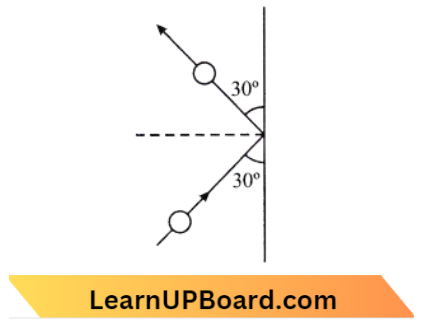
F x t = Change in momentum = 2 mv sinθ
⇒ F =\(\frac{2 m v \sin \theta}{t}\)
=\(\frac{2 \times 0.5 \times 12 \times \sin 30^{\circ}}{0.25}\)
∴ \(48 \times \frac{1}{2}=24 \mathrm{~N}\)
NEET Laws Of Motion Questions
Question 25. A body of mass 3 kg hits a wall at an angle of 60° and returns at the same angle. The impact time was 0.2 s. The force exerted on the wall is:
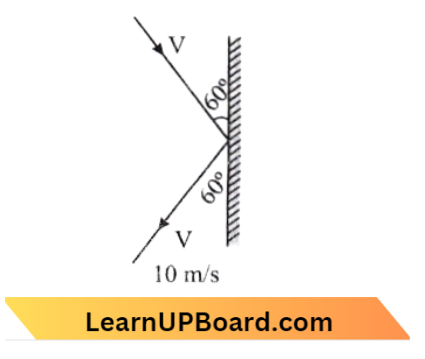
- \(150 \sqrt{3} \mathrm{~N}\)
- \(50 \sqrt{3} \mathrm{~N}\)
- 100
- \(75 \sqrt{3} \mathrm{~N}\)
Answer: 1. \(150 \sqrt{3} \mathrm{~N}\)
⇒ Change in momentum- mv2sin0- (mv1sinθ)= 2 mvsinθ = 2 x 3 X 10 x sin60°

⇒ 60x \(\frac{\sqrt{3}}{2}\)
⇒ Force =\(\frac{\text { Change in momentum }}{\text { Impact time }}\)
=\(\frac{30 \sqrt{3}}{0.2}=150 \sqrt{3} \mathrm{~N}\)
Question 26. An object flying in air with velocity \((20 \hat{i}+25 \hat{j}-12 \hat{k})\) suddenly breaks into two pieces whose masses are in the ratio 1: 5. The smaller mass flies off with a velocity \((100 \hat{i}+35 \hat{j}-8 \hat{k})\). The velocity of the larger piece will be:
- \((4 \hat{i}+23 \hat{j}-16 \hat{k})\)
- \((-100 \hat{i}+35 \hat{j}-8 \hat{k})\)
- \((20 \hat{i}+15 \hat{j}-80 \hat{k})\)
- \((-20 \hat{i}-15 \hat{j}-80 \hat{k})\)
Answer: 1. \((4 \hat{i}+23 \hat{j}-16 \hat{k})\)
From the law of conservation of linear momentum\(m \vec{v}=m_1 \overrightarrow{v_1}+m_2 \overrightarrow{v_2}\)
⇒ \(6 \mathrm{k}(20 \hat{i}+25 \hat{j}-12 \hat{k})=(100 \hat{i}+35 \hat{j}+8 \hat{k})+5 k \hat{v}_2\)
⇒ \(5 \vec{v}_2=(120-100) \hat{i}+(150-35) \hat{j}+(-72-8) \hat{k}\)
⇒ \(5 \vec{v}_2=20 \hat{i}+115 \hat{j}-80 \hat{k}\)
∴ \(\vec{v}_2=4 \hat{i}+23 \hat{j}-16 \hat{k}\)
NEET Laws Of Motion Questions
Question 27. What is the minimum velocity with which a body of mass m must enter a vertical loop of radius R so that it can complete the loop?
- \(\sqrt{2 g \mathrm{R}}\)
- \(\sqrt{3 g R}\)
- \(\sqrt{5 g \mathrm{R}}\)
- \(\sqrt{g \mathrm{R}}\)
Answer: 3. \(\sqrt{5 g \mathrm{R}}\)
When the minimum speed of the body is \(\sqrt{5 g R}\) then no matter from where it enters the loop, it will complete a full vertical loop.
Question 28. A bullet of mass 10 g moving horizontally with a velocity of 400 m/s strikes a wood block of inextensible string of length 5 m. As a result, the center of gravity of the block was found to rise a vertical distance of 10 cm. The speed of the bullet after it emerges horizontally from the block will be:
- 100 m/s
- 80 m/s
- 120 m/s
- 160 m/s
Answer: 3. 120 m/s
Given
A bullet of mass 10 g moving horizontally with a velocity of 400 m/s strikes a wood block of inextensible string of length 5 m. As a result, the center of gravity of the block was found to rise a vertical distance of 10 cm.
Applying law of conservation of momentum\(\frac{10}{1000} \times 400+0\)
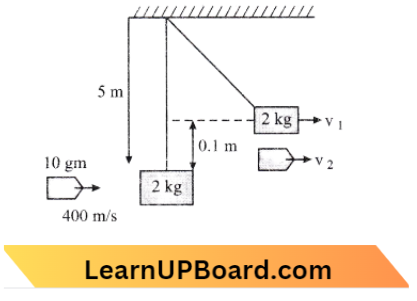
⇒ \(2 \times v_1+\frac{10}{1000} \times v_2\)
4 = 2v1 + 0.01 v2 → Equation – 1
⇒from the work-energy theorem for block, W=AKE
⇒ \(2 \times 10 \times 0.1=\frac{1}{2} \times 2 \times v_1^2\)
⇒ \(v_1=\sqrt{2}=1.4 \mathrm{~m} / \mathrm{s}\)
Putting the value of V1 in the equation. 1
⇒ 4 = 2 x 1.4 + 0.01 v2
∴ v2= 120 m/s
Physics MCQs For NEET With Answers
Question 29. A person holding a rifle (mass of person and rifle together is 100 kg) stands on a smooth surface and fires 10 shots horizontally, in 5 s. Each bullet has a mass of 10 g with a muzzle velocity of 800 m s-1. The final velocity acquired by the person and the average force exerted on the person are:
- -0.8 ms-1, 16N
- – 0.8 ms1, 8N
- -1.6ms-1, 16N
- -1.6ms-1, 8N
Answer: 1. -0.8 ms-1, 16N
P (initial) = P (final)
⇒ 0 = n x m x u + (M-n x m) x v where: n = 10, m = 10g = 0.01kg, u = 800m/s, M = 100kg
⇒ 0 = 10 x 0.01kg x 800m/s + (100kg – 10 x 0.01kg) x v
⇒ v=\(\frac{80 \mathrm{kgm} / \mathrm{s}}{99.9 \mathrm{kgm} / \mathrm{s}}\)
⇒ v=-0.8m/s
∴ Then F= \(\frac{\Delta \mathrm{P}}{\Delta \mathrm{t}}=\frac{10 \times 0.01 \mathrm{~kg} \times 800 \mathrm{~m} / \mathrm{s}}{5 \mathrm{~s}}=16 \mathrm{~N}\)
Question 30. An explosion breaks a rock into three parts in a horizontal plane. Two of them go off at right angles to each other. The first part of mass 1 kg moves with a speed of 12 ms-1 and the second part of mass 2 kg moves with 8 ms 1 speed, if the third part flies off with 4 ms-1 speed, then its mass is:
- 3 kg
- 5 kg
- 7 kg
- 17 kg
Answer: 2. 5 kg
Given
An explosion breaks a rock into three parts in a horizontal plane. Two of them go off at right angles to each other. The first part of mass 1 kg moves with a speed of 12 ms-1 and the second part of mass 2 kg moves with 8 ms 1 speed,
We know momentum, P = mv
⇒ Using the law of conservation of momentum\(1 \times 12 \hat{i}+2 \hat{i}+2 \times 8 \hat{j}+P_3 =0
P_3 =-(12 \hat{i}+16 \hat{j})\)
⇒ \(\left|P_3\right|=\sqrt{(12)^2+(16)^2} =\sqrt{144+256}\)
=\(20 \mathrm{~kg} \mathrm{~m} / \mathrm{s}\)
⇒ \(\text { Now, } \quad P_3 =m_3 v_3\)
∴ \(m_3=\frac{P_3}{v_3} =\frac{20}{4}=5 \mathrm{~kg}\)
Physics MCQs For NEET With Answers
Question 31. A solid cylinder of mass 3 kg is rolling on a horizontal surface with a velocity of 4 ms-1. It collides with a horizontal spring of force constant 200 Nm”1 The maximum compression produced in the spring will be:
- 0.5 m
- 0.6 m
- 0.7 m
- 0.2 m
Answer: 2. 0.6 m
It is given figure

⇒ mass = 3 kg, v = 4 ms 1 k = 200 Nm 1 for max compression.
⇒ P.E. of Spring = Less in K.E of cylinder
⇒ K.E. of cylinder =\(\frac{1}{2} m v^2+\frac{1}{2} I \omega^2\)
=\(\frac{1}{2} m v^2+\frac{1}{2}\left(\frac{1}{8} m l^2\right)\left(\frac{\mathrm{v}}{3}\right)^2\)
=\(\frac{1}{2} m v^2+\frac{1}{4} m v^2=\frac{3}{4} m v^2\)
⇒ And \(\quad \frac{1}{2} k x^2=\frac{3}{4} m v^2\)
⇒ \(\quad x^2 =\frac{\frac{3}{4}}{\frac{1}{2}} \times \frac{m v^2}{\mathrm{~K}}\)
⇒ \(x^2 =\frac{3}{4} \frac{m v^2}{\mathrm{~K}}\)
⇒ \(\quad x =\sqrt{\frac{3}{2} \times 3 \times \frac{11}{200}}\)
=\(\frac{3 \times 4}{20}=0.6 \mathrm{~m}\)
Physics MCQs For NEET With Answers
Question 32. A stone is dropped from a height of h. It hits the ground with a certain momentum p. If the same stone is dropped from a height 100% more than the previous height, the momentum, when it hits the ground, will change by:
- 68%
- 41%
- 200%
- 100%
Answer: 2. 41%
⇒ We know that, \(v=\sqrt{2 g h}\) and momentum,\(p=m v=p \propto \sqrt{h}\)
⇒ \(p \propto \sqrt{h}\)
⇒ \(\frac{p_2}{p_1}=\sqrt{\frac{h_2}{h_1}}=\sqrt{\frac{2 h}{h}}=\sqrt{2}\)
⇒ \(p_2=\sqrt{2} p_1\)
⇒ \(p_2=1.414 p_1\)
∴ \(\% \text { change }=\frac{p_2-p_1}{p_1} \times 100 \%=41 \%\)
Question 33. A shell, in flight, explodes into four unequal parts. Which of the following is conserved?
- Potential energy
- Momentum
- Kinetic energy
- Both 1 and 3.
Answer: 2. Momentum
Question 34. A man fires a bullet of mass 200 g at a speed of 5 m/s. The gun is of one kg mass. By what velocity does the gun rebound backward?
- 1 m/s
- 0.01 m/s
- 0.1 m/s
- 10 m/s.
Answer: 1. 1 m/s
⇒ Mass of bullet (m1) = 200 g = 0.2 kg
⇒ speed of bullet (v1) = 5 m/s
and mass of gun (m2) = 1 kg. Before firing, the total momentum is zero. After firing total momentum is m1V1 + m2V2
From the law of conservation of momentum m1V1 + m2v2 = 0
Newton’s Laws Of Motion MCQs
Question 35. A 600 kg rocket is set for a vertical firing. If the exhaust speed is 1000 ms-1, the mass of the gas ejected per second to supply the thrust needed to overcome the weight of the rocket is:
- 117.6 kgs-1
- 58.6 kgs-1
- 6kg-1
- 76.4 kg s-1
Answer: 3. 6kg-1
The thrust of a rocket is the force that accelerates it higher.
Thrust on the rocket at time t is given by,\(F=-u \frac{d m}{d t}\)
where u is the relative velocity of exhaust gases concerning the rocket. \(\frac{d m}{d t}\) is the rate of combustion of dt fuel at that instant.
⇒ \(F=-u \frac{d m}{d t}=m g\)
⇒ \(-\frac{d m}{d t}=\frac{m g}{u}\)
⇒ Here, m = 600 kg, u = 1000 ms-1
∴ \(-\frac{d m}{d t}=\frac{600 \times 10}{1000}=6 \mathrm{~kg} \mathrm{~s}^{-1}\)
Question 36. A body of mass 5 kg explodes at rest into three fragments with masses in the ratio 1:1:3. The fragments with equal masses fly in mutually perpendicular directions with speeds of 21 m/s. The velocity of the heaviest fragment in m/s will be:
- \(7 \sqrt{2}\)
- \(5 \sqrt{2}\)
- \(3 \sqrt{2}\)
- \(\sqrt{2}\)
Answer: 1. \(7 \sqrt{2}\)
Since the 5 kg body explodes into three fragments with masses in the ratio 1:1:3 thus, the masses of fragments will be 1 kg, 1 kg, and 3 kg respectively. The magnitude of the resultant momentum of two fragments each of mass 1 kg, moving with velocity 21 m/s, in perpendicular directions is
=\(\sqrt{\left(m_1 v_1\right)^2+\left(m_2 v_2\right)^2}\)
=\(\sqrt{(21)^2+(21)^2}=21 \sqrt{2} \mathrm{~kg} \mathrm{~m} / \mathrm{s}\)
⇒ According to the law of conservation of linear momentum.
∴ \(m_3 v_3=21 \sqrt{2} \text { or } 3 v_3=21 \sqrt{2}\)
Newton’s Laws Of Motion MCQs
Question 37. Two blocks A and B of masses 3 m and m respectively are connected by a massless and inextensible string. The whole system is suspended by a massless spring as shown in the figure. The magnitudes of acceleration of A and B immediately after the string is cut, are respectively:

- \(\mathrm{g}, \frac{g}{3}\)
- \(\frac{g}{3}, \mathrm{~g}\)
- \(\mathrm{g}, \mathrm{g}\)
- \(\frac{g}{3}, \frac{g}{3}\)
Answer: 2. \(\frac{g}{3}, \mathrm{~g}\)
This problem has two cases,
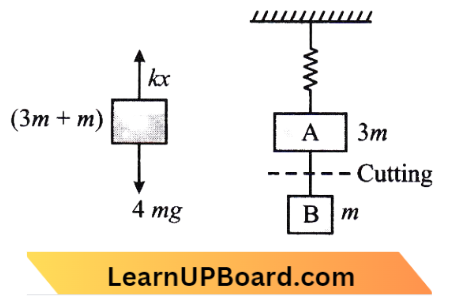
Case 1: The system is in equilibrium with a mass of 3m (weight = 4 mg) over the spring.
Case 2: When the string is cut according to the figure then:
1. free body diagram of mass m
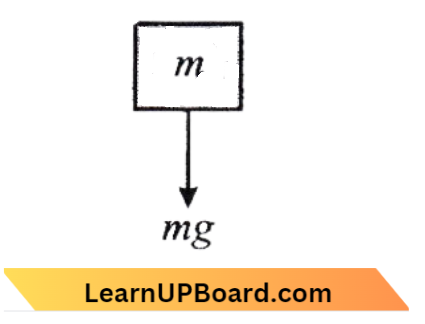
Here, the force of mass m = mg Acceleration = g
2. free body diagram of mass 3 m Net force,
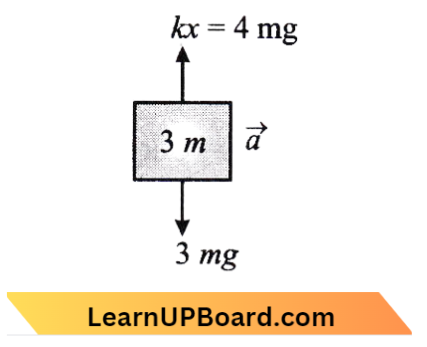
Ket = 4 mg-3 mg
3 m.a. = mg
⇒ \(a=\frac{g}{3}\)
From 1 and 2
∴acceleration of blocks A and B is a = \(\frac{g}{3}\) and a = g
Question 38. The displacement V (in meter) of a particle of mass ‘m’ (in kg) moving in one dimension under the action of a force is related to time V (in a sec) by i = \(\sqrt{x}\)+ 3 The displacement of the particle when its velocity is zero, will be:
- 4 m
- 0 m(zero)
- 6 m
- 2 m
Answer: 2. 0 m(zero)
According to the question t =\(\sqrt{x}+3\)
⇒ \(\sqrt{x} =t-3\)
⇒ Squaring both sides we get, x = (t- 3)² → Equation… 1
⇒ Now Velocity v= \(\frac{d x}{d t}=\frac{d}{d t}(t-3)^2\)= 2(t -3)
⇒ velocity becomes zero means 2(t-3) = 0
t = 3 sec.
At t = 3s → from…1
∴ x = (3 – 3)² = 0
Question 39. Calculate the acceleration of the block and trolly system shown in the figure. The coefficient of kinetic friction between the trolly and the surface is 0.05. g = 10 m/s², the mass of the string is negligible and no other friction exists).
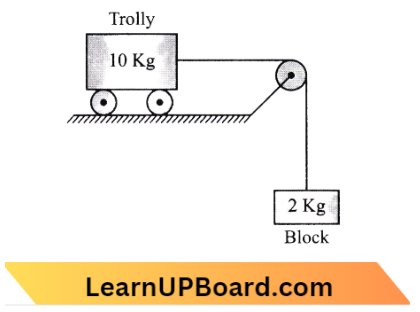
- 1.25 m/s²
- 1.50 m/s²
- 1.66 m/s²
- 1.00 m/s²
Answer: 1. 1.25 m/s²
The situation is shown in the figure
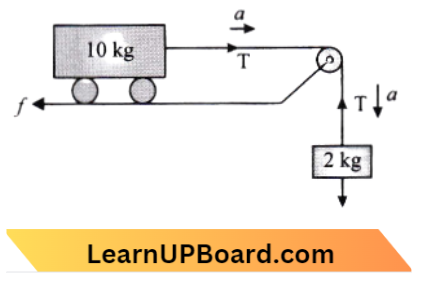
Here, a = acceleration of the system.
Here from free free-body diagram.
⇒ T- μR = 10a
T- 0.05 x log = 10a {tR = 0.05 x 100 = 5}
T-5 = 10a. → Equation.. 1
For a 2 kg block the equation of motion
⇒ 2g-T=20 2 x 10 – T = 2a
⇒ 20-T=2a → Equation ..2
From equation 1 and 2, we get T-5 = 10a
⇒ 20-T=2a
20-5 = 12a
15 = 12a
∴ a=\(\frac{15}{12}=\frac{5}{4}=1.25 \mathrm{~ms}^{-2}\)
Question 40. Two bodies of mass 4 kg and 6 kg are tied to the ends of a massless string. The string passes over a pulley which is frictionless (see figure). The acceleration of the system in terms of acceleration due to gravity g is:
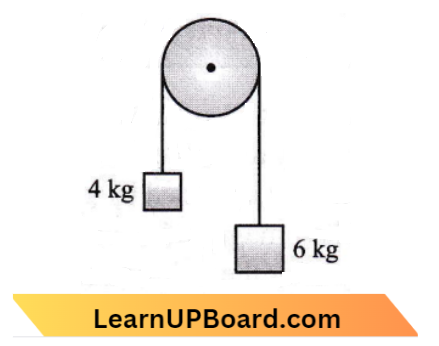
- \(\frac{g}{2}\)
- \(\frac{g}{5}\)
- \(\frac{g}{4}\)
- g
Answer: 2. \(\frac{g}{5}\)
Given that, m1= 4 kg m2 = 6 kg and a = ?
⇒ From the free free-body diagram,
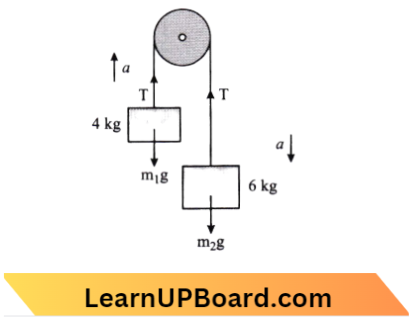
m2g- T = m2 a
⇒ T-m1g- m1a
⇒ (m2g- m1g) = m1a+ m2a
⇒ (m2– m1)g = a(m1+ m2)
⇒ \(a=\left(\frac{m_2-m_1}{m_1+m_2}\right) g\) → Equation 1
Putting the values of m1, m2, and g in equation 1.
⇒ \(a=\left(\frac{6-4}{4+6}\right) g=\frac{2}{10} g=\frac{g}{5}\)
∴ a=\(\frac{g}{5}\)
NEET Physics Chapter-Wise MCQs
Question 41. A body of mass m is kept on a rough horizontal surface (coefficient of friction = μ). Horizontal force is applied to the body, but it does not move. The resultant of the normal reaction and the frictional force acting on the object is given as F, where F is:
- \(|F|=m g+\mu m g\)
- \(|F|=\mu m g\)
- \(|F| \leq m g \sqrt{1+\mu^2}\)
- \(|F|=m g\)
Answer: 3. \(|F| \leq m g \sqrt{1+\mu^2}\)
Since the body does not move hence it is in equilibrium. Fr = Frictional force which is less than or equal to friction
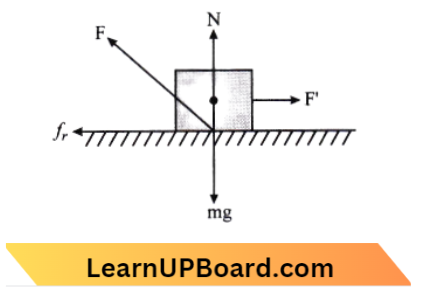
⇒ \(\mathrm{N}=m g\)
⇒ \(\overrightarrow{\mathrm{F}}=\overrightarrow{\mathrm{N}}+\vec{f}_r\)
⇒ \(|\overrightarrow{\mathrm{F}}| \leq(m g)^2+(\mu m g)^2\)
∴ \(|\overrightarrow{\mathrm{F}}| \leq m g \sqrt{1+\mu^2}\)
Question 42. Which one of the following statements is incorrect?
- Frictional force opposes the relative motion.
- The limiting value of static friction is directly proportional to normal reaction.
- Rolling friction is smaller than sliding friction.
- The coefficient of sliding friction has a dimension of length.
Answer: 4. The Coefficient of sliding friction has a dimension of length.
⇒ The coefficient of sliding friction is,\(\mu_{\mathrm{S}}=\frac{N}{F_{\text {sliding }}}\)
∴ The dimensions of N and F are the same. So, ^ is a dimensionless quantity.
Question 43. Three blocks A, B, and C of masses 4 kg. 2 kg, and 1 kg respectively, are in contact on a frictionless surface, as shown. If a force of 14 N is applied on the 4 kg block, then the contact force between A and B is:
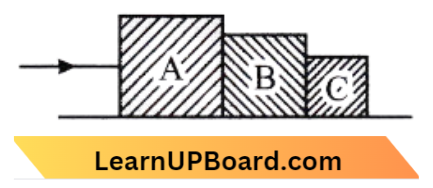
- 2 N
- 6 N
- 8 N
- 18 N
Answer: 2. 6 N
From the question, it is given that, MA = 4 kg, MB = 2 kg, MC = 1 kg
M = MA + MB + Mc = (4 + 2 + 1) = 7 kg
We know, that F = Ma
14 = 7a
a = 2 m/s²
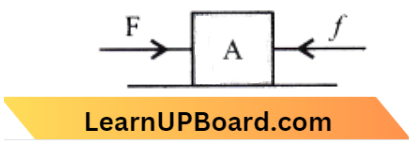
⇒ Let f be the contact force between A and B then the net force
F-f= 4a
14-f= 4×2
∴ f= 6N
Question 44. A Block A of mass m1 rests on a horizontal table. A light string connected to it passes over a frictionless pulley at the edge of the table and from its other another block B of mass m2 is suspended. The coefficient of kinetic friction between the block and the table is μk When the, T block A is sliding on the table, the tension in the string is:
- \(\frac{\left(m_2+\mu_k+m_1\right) g}{\left(m_1+m_2\right)}\)
- \(\frac{\left(m_2-\mu_k m_1\right) g}{\left(m_1+m_2\right)}\)
- \(\frac{m_1 m_2\left(1+\mu_g\right) g}{\left(m_1+m_2\right)}\)
- \(\frac{m_1 m_2\left(1-\mu_k\right) g}{\left(m_1+m_2\right)}\)
Answer: 4. \(\frac{m_1 m_2\left(1-\mu_k\right) g}{\left(m_1+m_2\right)}\)
Given
A Block A of mass m1 rests on a horizontal table. A light string connected to it passes over a frictionless pulley at the edge of the table and from its other another block B of mass m2 is suspended. The coefficient of kinetic friction between the block and the table is μk When the, T block A is sliding on the table,
The situation is

Let T be the tension in the string a be the acceleration of the block. Then from the free body diagram of and B is
From both the diagram, we have,
m2g- T = m2a → equation 1
T-μRm1g = m1a → Equation 2
From eq. 1 and 2,
m2S – μRm1g = (m1+ m2)a
⇒ \(a=\frac{\left(m_2-m_1\right) g}{m_1+m_2}\)
Putting The value of A in Equation 1
T=\(m_2 g-m_2 a\)
=\(m_2 g-m_2\left[\frac{\left(m_2-\mu_k m_1\right) g}{m_1+m_2}\right]\)
=\(m_2 g\left[1-\frac{\left(m_2-\mu_k m_1\right) g}{m_1+m_2}\right]\)
∴ T =\(\frac{m_1 m_2\left(1+\mu_k\right) g}{m_1+m_2}\)
NEET Physics Chapter-Wise MCQs
Question 45. A plank with a box on one end is gradually raised about the other end. As the angle of inclination with the horizontal reaches 30°, the box starts to slip and slides 4.0 m down the plank in 4.0 s. The coefficient of static and kinetic friction between the box and the plank will be respectively:
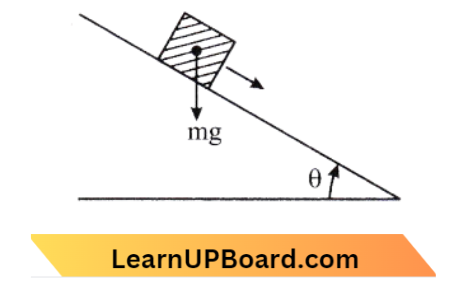
- 0.6 and 0.6
- 0.6 and 0.5
- 0.5 and 0.6
- 0.4 and 0.3
Answer: 2. 0.6 and 0.5
The situation is shown in the figure
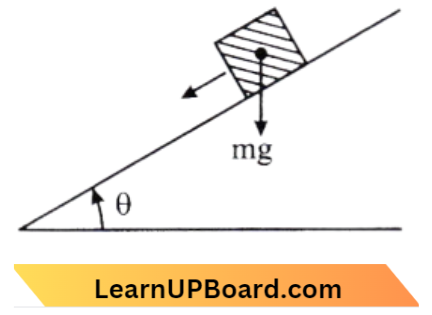
⇒ Here coefficient of static friction,\(\mu_s=\tan 30^{\circ}=\frac{1}{\sqrt{3}}=0.6\)
⇒ And distance covered by plank,\(S=u t+\frac{1}{2} a t^2\)
⇒ Here, u = 1 and a = g (sin θ – μ cos θ)=\(4=\frac{1}{2} g\left(\sin 30^{\circ}-\mu_k \cos 30^{\circ}\right)(4)^2\)
⇒ \(0.5 =10 \times \frac{1}{2}-\mu_k \times 10 \times \frac{\sqrt{3}}{2}\)
⇒ \(5 \sqrt{3} \mu_k =45\)
∴ \(\mu_k =0.51\)
Question 46. A system consists of three masses m1, m2, and m3 connected by a string passing over a pulley P. The m1 hangs freely and m2 and w3 are on a rough horizontal table (the coefficient of friction = μ). The pulley is frictionless and of negligible mass. The downward acceleration of mass m1 is (Assume, m1 = m2 = m3 = m):
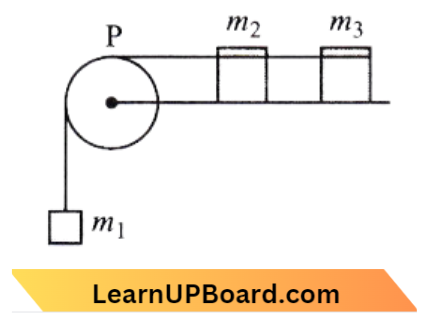
- \(\frac{g(1-g \mu)}{g}\)
- \(\frac{(2 g \mu)}{3}\)
- \(\frac{g(1-2 \mu)}{3}\)
- \(\frac{g(1-2 \mu)}{2}\)
Answer: 3. \(\frac{g(1-2 \mu)}{3}\)
Consider free body diagram for block m1V1
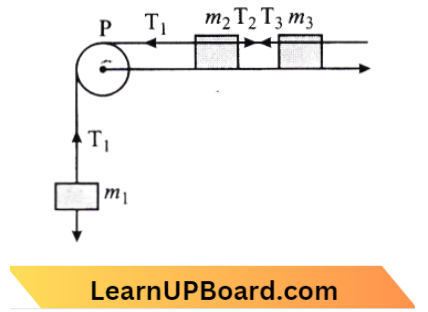
⇒ Here m1 = m2 = m2
mg-T1 = ma → Equation 1
For block m2 and m3
T1 -2μmg = 2ma → Equation 2
Solving equation 1 and 2
mg- T1 = ma
T1– 2μmg = 2 ma
mg- 2μmg = 3ma
mg(1- 2μ) = 3pa
⇒ \(a=\frac{g(1-2 \mu)}{3}\)
∴ This is a downward acceleration of mass
NEET Physics Chapter-Wise MCQs
Question 47. The upper half of an inclined plane of inclination θ is perfectly smooth while the lower half is rough. A block starting from rest at the top of the plane will again come to rest at the bottom. The coefficient of friction between the block and the lower half of the plane is given by:
- \(\mu=\frac{1}{\tan \theta}\)
- \(\mu=\frac{2}{\tan \theta}\)
- \(\mu=2 \tan \theta\)
- \(\mu=\tan \theta\)
Answer: 3. \(\mu=2 \tan \theta\)
From work energy theorem
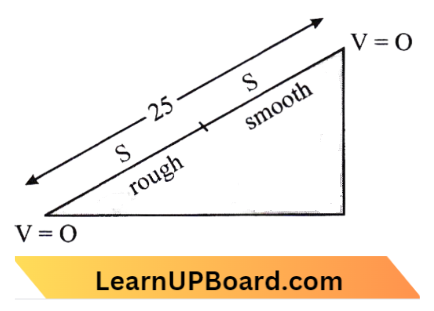
(mg sin θ) (2S)- (μmg cos θ) 5 = 0- 0
mg sin θ(2s)- (μ mg cos θ)S = 6
2s Sin θ- μs cos θ = 0
2 Sin θ- p cos θ = 0
μ cos θ = 2 sin θ
∴ \(\mu=2 \frac{\sin \theta}{\cos \theta}=2 \tan \theta\)
Question 48. A block of mass 5 kg is placed on a horizontal surface and a pushing force of 20 N is acting on the block as shown in the figure. If the coefficient of friction between the block and the surface is 0.2, then calculate the speed of the block after 15. (Given g = 10 m/s²):
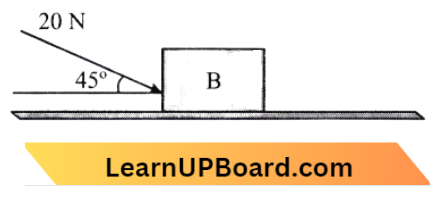
- 3.936 m/s
- 6.396 m/s
- 9.369 m/s
- 3.215 m/s
Answer: 1. 3.936 m/s
The different forces acting on the block are shown in the given figure
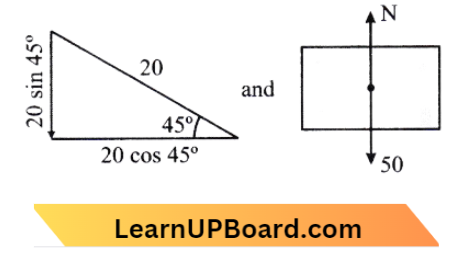
Horizontal component = 20 cos 45°
Vertical component = 20 sin 45°
Now we can write, 20 cos 45°-f= 5a → Equation 1
Where = frictional force
= μN
= 0.2 x N → Equation 2
And N = 5g + 20 sin 45° = 50 +10/2
Considering eq. 1 frictional force in eq 1
= 10V2– 0.2(50 +10V1)2624
⇒ speed ofblock after 15 sec. is v = u + at
= 0.2624 x 15 = 3.936 ms-1
Motion And Force MCQs For NEET
Question 49. Block B is pushed momentarily along a horizontal surface with an initial velocity v. If μ is the coefficient of sliding friction between B and the surface, block B will come to rest after a time.
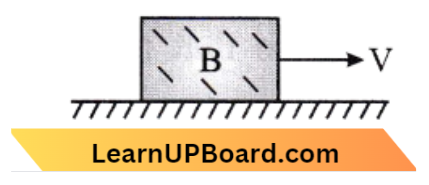
- \(\frac{g \mu}{v} s\)
- \(\frac{v}{g} s\)
- \(\frac{v}{g} s\)
- \(\frac{v}{g \mu} s\)
Answer: 3. \(\frac{v}{g} s\)
By Using, v =u+at
0 =\(v-\mu g t\)
t =\(\frac{v}{\mu g}\)
Question 50. The coefficient of static friction μg, between block A of mass 2 kg and the table as shown in the figure is 0.2. What would be the maximum mass value of block B so that the two blocks do not move? The string and the pulley are assumed to be smooth and massless. (g = 10 m/s2):
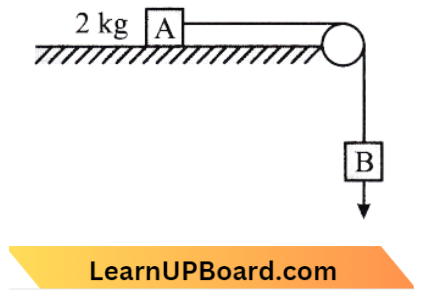
- 2.0 kg
- 4.0 kg
- 0.2 kg
- 0.4 kg
Answer: 4. 0.4 kg
⇒ According To Question,
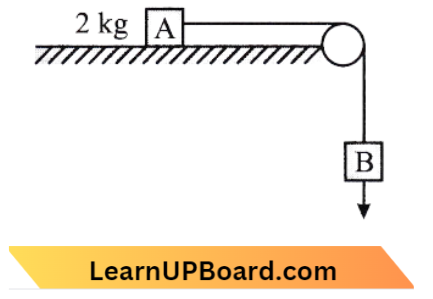
T=\(m_{\mathrm{B}} g=\mu\left(m_{\mathrm{A}} g\right)\)
∴ \(m_{\mathrm{B}} =\mu m_{\mathrm{A}}=0.02 \times 2 =0.4 \mathrm{~kg}\)
Question 51. A block of mass 10 kg placed on the rough horizontal surface having a coefficient of friction p = 0.5, if a horizontal force of 100 N acting on it then the acceleration of the block will be:
- 10 ms-1
- 5 ms-2
- 15 ms-2
- 0.5 ms-2
Answer: 2. 5 ms-2
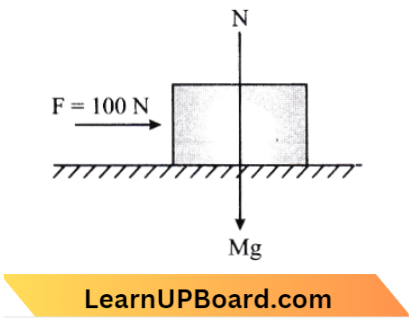
⇒ Here,\(f_{\max } =\mu N=\mu m g\)
=\(0.5 \times 10 \times 10=50 \mathrm{~N}\)
⇒ \(\quad a =\frac{\text { net force }}{\text { mass }}\)
=\(\frac{100-50}{10}=5 \mathrm{~m} / \mathrm{sec}^2\)
Question 52. A lift of mass 1000 kg which is moving with an acceleration of 1 ms-2 in the upward direction, then the tension developed in the string which is connected to the lift is:
- 9800 N
- 10,800 N
- 11000 N
- 10,000 N
Answer: 2. 10,800 N
∴ Using the equation,T=m(g + a) = 1000(9.8 + 1) = 10800 N
Motion And Force MCQs For NEET
Question 53. A block has been placed on an inclined plane with a slope angle of θ, band the lock slides down the plane at constant speed. The coefficient of kinetic friction is equal to:
- sin θ
- cos θ
- g
- tan θ
Answer: 4. tan θ
The angle of sliding is defined as the minimum angle of inclination of a plane with the horizontal, such that a body placed on the plane just begins to slide down.
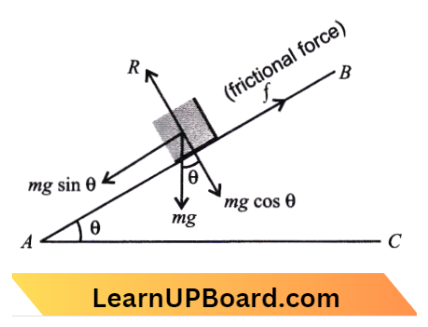
AB is an inclined plane such that a body placed on it just begins to slide down.
⇒ \(\angle \mathrm{BAC}=\theta\)= angle of repose
⇒ In equilibrium, f =\(m g \sin \theta\) and R =\(m g \cos \theta\)
⇒ \(\frac{f}{R} =\frac{m g \sin \theta}{m g \cos \theta}=\tan \theta\)
∴ \(\mu=\tan \theta\)
Question 54. A heavy uniform chain lies on the horizontal table top. If the coefficient of friction between the chain and the table surface is 0.25, then the maximum friction of the length of the chain that can hang over one edge of the table is:
- 20%
- 25%
- 35%
- 15%
Answer: 1. 20%
The force of friction should balance the weight of the chain hanging. If M is the mass of the whole chain of length L and x is the length of the chain hanging to balance, then
⇒ \(\mu \frac{M}{L}(L-x) g=\frac{M}{L} x g\) or
⇒ \(\mu(L-x)=x or\)
x=\(\frac{\mu L}{\mu+1}=\frac{0.25 L}{1.25}\)
x=\(\frac{L}{5}\) or
∴ \(\frac{x}{L} =\frac{1}{5}=\frac{1}{5} \times 100\) =20 \%
Question 55. A block of mass 10 kg is in contact with the inner wall of a hollow cylindrical drum of radius 1 m. The coefficient of friction between the block and the inner wall of the cylinder is 0.1. The minimum angular velocity needed for the cylinder to keep the block stationery when the cylinder is vertical and rotating about its axis will be (g = 10 m/s²):
- \(\frac{10}{2 \pi} \mathrm{rad} / \mathrm{s}\)
- \(10 \mathrm{rad} / \mathrm{s}\)
- \(10 \pi \mathrm{rad} / \mathrm{s}\)
- \(\sqrt{10} \mathrm{rad} / \mathrm{s}\)
Answer: 2. \(10 \mathrm{rad} / \mathrm{s}\)
Given
A block of mass 10 kg is in contact with the inner wall of a hollow cylindrical drum of radius 1 m. The coefficient of friction between the block and the inner wall of the cylinder is 0.1.
⇒ To keep the block stationary Frictional force\( \geq \)weight
Here,\(\mu N \geq M g\)
⇒ N=\(\mathrm{M} \omega^2 r \quad\{\text { Hence, } r=1 m, \mu=0.1\}\)
⇒ \(M \omega^2 r =M g\)
⇒ \(\omega =\sqrt{\frac{g}{\mu r}}=\sqrt{\frac{10}{0.1 \times 1}}\)
=\(10 \mathrm{rad} \mathrm{s}^{-1}\)
Motion And Force MCQs For NEET
Question 56. Two particles A and B are moving in a uniform circular motion in the concentric circles of radii rA and rB with speeds vA and vB respectively. Their period of rotation is the same. The ratio of the angular speed of A to that of B will be :
- vA: vB
- rB: rA
- 1: 1
- rA: rB
Answer: 3. 1: 1
Given
Two particles A and B are moving in a uniform circular motion in the concentric circles of radii rA and rB with speeds vA and vB respectively. Their period of rotation is the same.
We know that:
Time period\(T=\frac{2 \pi}{\omega}\)
Where, ω = angular speed
According to the question,
⇒ \(T_A =T_B\)
⇒ \(\frac{2 \pi}{\omega_{\mathrm{A}}} =\frac{2 \pi}{\omega_{\mathrm{B}}}\)
⇒ \(\omega_{\mathrm{A}}=\omega_{\mathrm{B}}\)
∴ \(\omega_{\mathrm{A}}: \omega_{\mathrm{B}}\) =1: 1
Question 57. In the given figure a = 15 m/s² represents the total acceleration of a particle moving in the clockwise direction in a circle of radius R = 0.2 m at a given instant of time. The speed of the particle is:
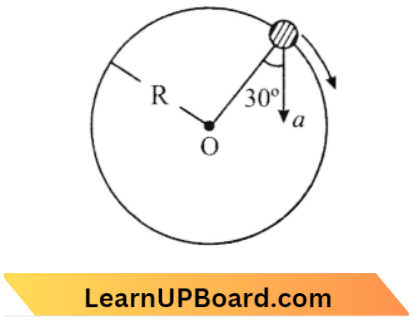
- 4.5 m/s
- 5.0 m/s
- 5.7 m/s
- 6.2 m/s
Answer: 3. 5.7 m/s
The particle is moving in a circle of radius R. So acceleration will be:
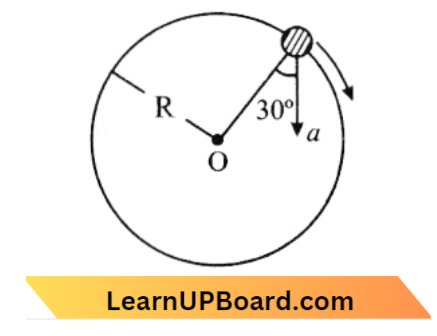
⇒ \(a_c=\frac{\mathrm{v}^2}{\mathrm{R}}\)
from figure ac = a cos 30°
⇒ \(\frac{v^2}{R}\)= a cos 30°
v² = a cos 30° x R = 15 x cos 30° x 2.5
v² = 15×2.5x\(\frac{\sqrt{3}}{2}\)
∴ v = 5.7 m/s
Motion And Force MCQs For NEET
Question 58. A car is negotiating a curved road of radius R. The road is banked at an angle θ. The coefficient of friction between the tires of the car and the road is ps. The maximum safe velocity on this road is:
- \(\sqrt{\frac{g}{R} \frac{\mu_s+\tan \theta}{1-\mu_s \tan \theta}}\)
- \(\sqrt{\frac{g}{R^2} \frac{\mu_s+\tan \theta}{1-\mu_s \tan \theta}}\)
- \(\sqrt{g R^2 \frac{\mu_s+\tan \theta}{1-\mu_s \tan \theta}}\)
- \(\sqrt{g R \frac{\mu_s+\tan \theta}{1-\mu_s \tan \theta}}\)
Answer: 4. \(\sqrt{g R \frac{\mu_s+\tan \theta}{1-\mu_s \tan \theta}}\)
For vertical equilibrium on the road, N cosθ = mg +sinθ
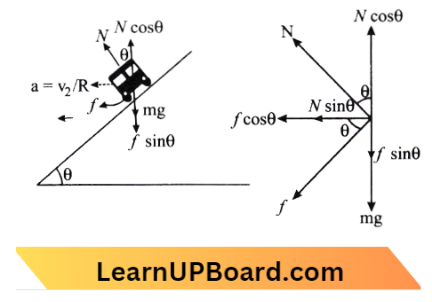
mg = N cosθ – fsinθ → Equation 1
⇒ Centripetal force for safe turning, \(N \sin \theta+f \cos \theta=\frac{m v^2}{R}\)
⇒ From Equations 1 And 2, We get \(\frac{v^2}{R g}=\frac{N \sin \theta+f \cos \theta}{N \cos \theta-f \sin \theta}\)
⇒ \(\frac{v_{\max }^2}{R g}=\frac{N \sin \theta+\mu_s N \cos \theta}{N \cos \theta-\mu_s N \sin \theta}\)
∴ \(\mathrm{v}_{\max }=\sqrt{R g\left(\frac{\mu_s+\tan \theta}{1-\mu_s \tan \theta}\right)}\)
Question 59. Two stones of masses m and 2m are whirled in horizontal circles, the heavier one in a radius r/2 and the lighter one in a radius r. The tangential speed of lighter stones is n times that of the value of heavier stones when they experience the same centripetal forces. The value of n is:
- 4
- 1
- 2
- 3
Answer: 3. 2
⇒ Let v be the tangential speed of the heavier stone. Then, centripetal force experienced by lighter stone is\(\left(F_c\right)_{\text {lighter }}=\frac{m(n v)^2}{r}\)
and that of heavier stone is \(\left(F_c\right)_{\text {heavier }}=\frac{2 m v^2}{r / 2}\)
⇒ \(\text { But, } \left(F_c\right)_{\text {lighter }}=\left(F_c\right)_{\text {heavier }}\)
⇒ \(\quad \frac{m(n v)^2}{r} =\frac{2 m v^2}{(r / 2)}\)
⇒ \(\text { or, } \quad n^2\left(\frac{m v^2}{r}\right) =4\left(\frac{m v^2}{r}\right)\)
∴ \(n^2 =4 \text { or } n=2\)
Question 60. A car is moving in a circular horizontal track with a radius of 10 m with a constant speed of 10 m/s. A bob is suspended from the roof of the car by a light wire of length 1.0 m. The angle made by the wire with the vertical is:
- π/3
- π/6
- π/4
- 0°
Answer: 3. π/4
⇒Let θ be the angle made by the wire with the vertical.\(\tan \theta=\frac{v^2}{r g}\)
⇒ Here, v= 10 m/s, r = 10 m, g= 10 m/s²
⇒ \(\tan \theta =\frac{(10 m / s)^2}{10 m\left(10 m / s^2\right)}\)=1
∴ \(\theta =\tan ^{-1}(1)=\frac{\pi}{4}\)
Motion And Force MCQs For NEET
Question 61. A car of mass 1000 kg negotiates a banked curve of radius 90 m on a frictionless road. If the banking angle is 45°, the speed of the car is:
- 20 m s-1
- 30 m s-1
- 5 m s-1
- 10 m s-1
Answer: 2. 30 m s-1
Here, m = 1000 kg, R = 90 m, 0 = 45°
∴ For banking, \(\tan \theta=\frac{v^2}{R g}\) = 30 ms-1
Question 62. A car of mass m is moving on a level circular track of radius R. If ps represents the static friction between the road and tires of the car, the maximum speed of the car in circular motion is given by:
- \(\sqrt{\mu_s m R g}\)
- \(\sqrt{\frac{R g}{\mu_s}}\)
- \(\sqrt{\frac{m R g}{\mu_s}}\)
- \(\sqrt{\mu_s R g}\)
Answer: 4. \(\sqrt{\mu_s R g}\)
The force of friction provides the necessary centripetal force
⇒ \(\frac{m v^2}{R} \leq \mu_{\mathrm{s}} \mathrm{N}\)
⇒ \(v^2 \leq \frac{\mu_s R N}{m}\)
⇒ \(v^2 \leq \mu_{\mathrm{s}} \mathrm{Rg}\)
∴ The maximum speed of the car in circular motion is \(\mathrm{v}_{\max }=\sqrt{\mu_s R g}\)
Question 63. A car of mass 1000 kg negotiates a banked curve of radius 9.0 m on a frictionless road. If the banking angle is 45°, the speed of the car is:
- 20 ms-1
- 30 ms-1
- 5 ms-1
- 10ms-1
Answer: 2. 30 ms-1
Given banking angle = 45°
Radius = 90 m and g = 10 m/s²
Now banking angle, tan \(\theta=\frac{v^2}{r g}\)
⇒ \(\tan 45^{\circ} =\frac{v^2}{90 \times 10}\)
⇒ \(v^2 =90 \times 10 \times \tan 45^{\circ}\)
v =\(\sqrt{90 \times 10 \times \tan 45^{\circ}}=30\)
∴ Speed of car v = 30 m/s
Question 64. A car runs at a constant speed on a circular track with a radius of 100 m, taking 62.8 seconds for every circular lap. The average velocity and average speed for each circular lap respectively is:
- 10 m/s, 0
- 0, 0
- 0, 10 m/s
- 10 m/s, 10 m/s
Answer: 1. 10 m/s, 0
Distance traveled in one revolution = 2 r
⇒ \(\text { Average speed }=\frac{\text { Totaldistance }}{\text { Total time }}\)
⇒ \(\frac{2 \pi r}{t}=\frac{2 \times 3.14 \times 100}{62.8}\)
Displacement in one revolution is zero
∴ \(\text { Average Velocity }=\frac{\text { Net displacement }}{\text { Time }}=\frac{0}{t}\)=0
Question 65. A ball of mass 0.25 kg attached to the end of a string of length 1.96 m is moving in a horizontal circle. The string will break if the tension is more than 25 N. What is the maximum speed with which the ball can be moved?
- 14 m/s
- 3 m/s
- 3.92 m/s
- 5 m/s
Answer: 1. 14 m/s
For a ball to move in a horizontal circle, the ball should satisfy the condition
Tension is the string = Centripetal force
⇒ \(T_{\max }=\frac{M v_{\max }^2}{R}\)
⇒ \(v_{\text {max }}=\sqrt{\frac{T_{\max } \cdot R}{M}}\)
∴ Making substitution, we obtain,\(v_{\max }=\sqrt{\frac{25 \times 1.96}{0.25}}=\sqrt{196}=14 \mathrm{~m} / \mathrm{s}\)
Question 66. Two racing cars of masses m and 4 m are moving in circles of radii r and 2r respectively. If their speeds are such that each makes a complete circle at the same time, then the ratio of the angular speeds of the first to the second car is:
- 8 :1
- 4: 1
- 2 :1
- 1: 1
Answer: 4. 1: 1
⇒ We have, \(\omega=\frac{2 \pi}{t}\)
∴ Since both cars take the same time to complete the circle. Therefore the ratio of angular speeds of the cars will be 1: 1
Question 67. A balloon with mass m is descending with an acceleration a (where a < g). How much mass should be removed from it so that it starts moving up with an acceleration?
- \(\frac{2 m a}{g+a}\)
- \(\frac{2 m a}{g-a}\)
- \(\frac{m a}{g+a}\)
- \(\frac{m a}{g-a}\)
Answer: 1. \(\frac{2 m a}{g+a}\)
Let F be the upthrust of the air. As the balloon is descending with an acceleration a, mg – F = ma Equation 1
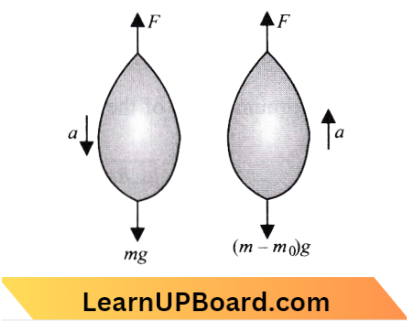
Let the mass be removed from the balloon so that it starts moving up with an acceleration a. Then, F- (m- m0)g ={m- m0)a
F- mg + m0g = ma- m0a → Equation 2
⇒ Adding equation. 1 and equation. 2, we get
m0g = 2ma- m0a;
m0g + m0a = 2ma
⇒ m0(g + a) = 2ma
∴ \(\mathrm{m}_0=\frac{2 m a}{g+a}\)
Laws Of Motion Questions For NEET
Question 68. Three blocks with mass m, 2m, and 3m are F connected by strings, as shown in the figure. T After an upward force F is applied on block m, the masses move upward at constant speed v. What is the net force on the block of mass 2m? (g is the acceleration due to gravity)

- 3 mg
- 6 mg
- zero
- 2 mg
Answer: 3. zero
∴ As all blocks are moving with constant speed, therefore, acceleration is zero. So net force on each block is zero.
Question 69. A person of mass 60 kg is inside a lift of mass 940 kg and presses the button on the control panel. The lift starts moving upwards with an acceleration of 1.0 m/s². If g = 10 m s-2, the tension in the supporting cable is:
- 8600 N
- 9680 N
- 11000 N
- 1200 N
Answer: 3. 11000 N
Here, the Mass of the person, m = 60 kg
Mass of lift, M= 940 kg,
a = 1 m/s², g = 10 m/s²
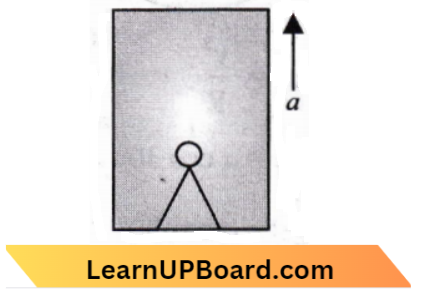
Let T be the tension in the supporting cable.
T-(M+m)g = (M+m)a
T = (M+ m) (a + g)
= (940 + 60) (1 + 10)= 11000N
Question 70. The mass of a lift is 2000 kg. When the tension in the supporting cable is 28000 N, then its acceleration is:
- 4 m s-2upwards
- 4 m s-2 downwards
- 14 ms-2 upwards
- 30 m s-2 downwards
Answer: 1. 4 m s-2 upwards
⇒ F- Mg = MA
8000 = 2000a
a = 4
∴ Acceleration is 4 m s-2 upwards
Laws Of Motion Questions For NEET
Question 71. A block of mass m is placed on a smooth wedge of inclination θ. The whole system is accelerated horizontally so that the block does not slip on the wedge. The force exerted by the wedge on the block will be (g is the acceleration due to gravity):
- mg cosθ
- mg sinθ
- mg
- mg/cosθ
Answer: 4. mg/cosθ
The wedge is given an acceleration to the left.
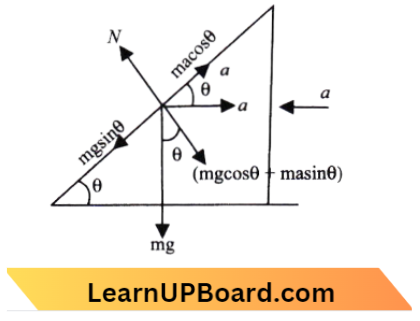
The block has a pseudo acceleration to the right, pressing against the wedge because of which the block is not moving.
⇒ \(m g \sin \theta=m a \cos \theta\)
∴ The total reaction of the wedge on the block is N = mg cosθ + ma sinθ
Question 72. A monkey of mass 20 kg is holding a vertical rope. The rope will not break when a mass of 25 kg is suspended from it but will break if the mass exceeds 25 kg. What is the maximum acceleration with which the monkey can climb up along the rope? (g = 10 m/s²):
- 5 m/s²
- 10 m/s²
- 25m/s²
- 2.5 m/s²
Answer: 4. 2.5 m/s²
Let T be the tension in the rope when the monkey climbs up with an acceleration a. Then, T- mg = ma
25g- 20g = 20a
∴ \(\mathrm{a}=\frac{5 \times 10}{20}=2.5 \mathrm{~m} / \mathrm{s}^2\)
Question 73. A lift of mass 1000 kg which is moving with the acceleration of 1 m/s² in an upward direction, then the tension developed in the string which is connected to the lift is:
- 9800N
- 10,800N
- 11,000 N
- 10,000 N
Answer: 4. 10,000 N
For a lift that is moving in an upward direction with acceleration a, the tension T developed in the string connected to the lift is given by T- m (g + a). Here m = 1000 kg, a = 1 m/s², g = 9.8 m/s² T= 1000(9.8+ 1)= 10,800 N
Laws Of Motion Questions For NEET
Question 74. A mass M is placed on a very smooth wedge resting on a surface without friction. Once the mass is released, the acceleration to be given to the wedge so that M remains at rest is where
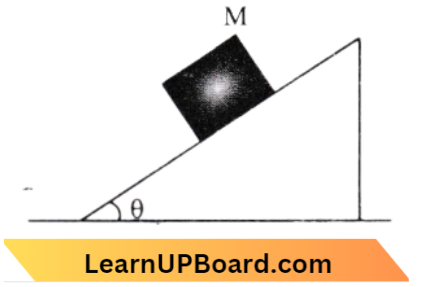
- a is applied to the left and a = g tanθ
- a is applied to the right and a = g tanθ
- a is applied to the left and a = g sinθ
- a is applied to the left and a = g cosθ
Answer: 1. a is applied to the left and a = g tanθ
The pseudo acceleration for the body a’ = a
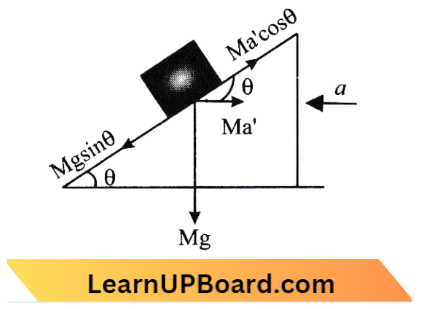
If the pseudo force Macosθ = Mgsinθ, then the body will be at rest,
∴ This horizontal acceleration should be applied to the wedge to the left.
Question 75. A monkey is descending from the branch of a tree with constant acceleration. If the breaking strength of the branch is 75% of the weight of the monkey, the minimum acceleration with which the monkey can slide down without breaking the branch is:
- g
- 3g/4
- g/4
- g/2
Answer: 3. g/4
Let T be the tension in the branch of a tree when the monkey is descending with acceleration Thus, mg – T = ma
also, T = 75% of the weight of the monkey
⇒ \(\mathrm{T} =\left(\frac{75}{100}\right) \mathrm{mg}=\frac{3}{4} m g\)
⇒ \(\mathrm{ma} =\mathrm{mg}-\left(\frac{3}{4}\right) \mathrm{mg}=\frac{1}{4} \mathrm{mg}\)
or \(\mathrm{a}=\frac{g}{4}\)
